Ugaritic Library (12 vols.)
Digital Logos Edition
Overview
The Ugaritic Library contains the complete corpus of Ugaritic texts together with aids and indices to better illuminate these ancient writings and the Hebrew Bible. These include grammatical and lexical books to help the reader learn and read Ugaritic, translations of many of the important documents (with commentary), and volumes designed to help the Bible student easily locate the places where Ugaritic can shed some light on the text of the Hebrew Bible.
Why Ugaritic?
For a more detailed response to this question, see Dr. Michael Heiser's article "What's Ugaritic Got to do with Anything?"
The Ugaritic texts are basic background material for the study of the Bible. Ugaritic is the ancient language of one of Israel’s closest neighbors, the city state of Ras Shamra, located in what is now Syria. Ugaritic is from the same family of languages as Hebrew, Northwest Semitic. This means the Ugaritic texts are closely related to the Hebrew Bible, both linguistically and culturally. The religious texts discuss deities named in the Bible, such as Baal and El, whose descriptions contain titles and phrases attributed to the God of Israel in the Bible. Ugaritic is also one of the most important languages used to help discern the meaning of difficult Hebrew words and phrases.

While most of the Ugaritic in this product is transliterated, which is easier to read than the cuneiform letters, Logos Bible Software is able to display and search on cuneiform Ugaritic text. Above is a sample of the font we designed for this project. Find out why this ancient language is important to you by reading Dr. Michael Heiser's article on Ugaritic studies.
With the Logos Bible Software edition, the various reference schemes for the Ugaritic tablets (such as KTU, CTA and UT numbers) are mapped, so that all of the Ugaritic and Hebrew books that cite the Ugaritic corpus can function together as an integrated whole, regardless of which citation format is used. Citations in biblical commentaries and lexicons will be able to link to the Ugaritic materials using any of these reference schemes. This makes the digital editions far easier to use than their print counterparts.
In addition, the Ugaritic materials in English translations previously published in Hallo's The Context of Scripture (3 vols.) have been reworked to be integrated with the Ugaritic Library. References to the Ugaritic corpus within key Hebrew grammars and lexicons are already tagged. In particular, Koehler, Baumgartner and Stamm's Hebrew and Aramaic Lexicon of the Old Testament (HALOT) (5 vols.), the excellent Dictionary of Deities and Demons in the Bible, Joüon and Muraoka’s A Grammar of Biblical Hebrew: Revised English Edition, and Waltke and O'Connor's An Introduction to Biblical Hebrew Syntax have already been tagged with references to the Ugaritic Library. References to Ugaritic tablets are tagged for quick linking, as well as making it easy to search the entire library for references to any Ugaritic passage. In the future, references to the Ugaritic materials in the more technical biblical commentaries will also be tagged.
Use this resource alongside:
This title is included in the following collections
You can save when you purchase this product as part of a collection.
Logos 6 Lutheran Platinum Lega...
$1,499.99$1,499.99Logos 7 Baptist Diamond Legacy...
$2,999.99$2,999.99Logos 7 Lutheran Diamond Legac...
$2,999.99$2,999.99Logos 6 Baptist Diamond Legacy...
$2,999.99$2,999.99
- $2,999.99
- $4,749.99$3,562.49
- $4,749.99
- $4,749.99
- $4,749.99
- $4,749.99
- $4,749.99
- $11,399.99
- $23,999.99$17,999.99
- $24,999.99

- Title: Ugaritic Library (12 vols.)
- Volumes: 12
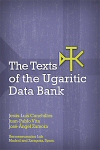
The Texts of the Ugaritic Data Bank
- Editors: Jesu´s-Luis Cunchillos, Juan-Pablo Vita and Jose´-A´ngel Zamora
- Publisher: Laboratorio de Hermeneumatica
- Publication Date: 2005
The Texts of the Ugaritic Data Bank has been established by J.-L. Cunchillos et alii, Hermeneumatics Lab (CSIC- Madrid y Zaragoza. Spain). This resource includes transcriptions of the entire corpus of Ugaritic alphabetic texts with bibliography, variant readings from a wide variety of publications, notes on the tablets, including provinence and dimensions, and maps. The Logos Bible Software edition has linked the citations in the UDB up to citation systems for KTU, CTA, UT and others to allow easy navigation based on a wide variety of data types. Thus the Ugaritic data Bank can be easily used in conjunction with other Ugaritic titles, no matter which common reference scheme is used to cite the texts.
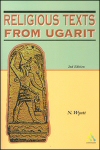
Religious Texts from Ugarit contains accurate and readable English translations of the most important religious texts, along with extensive notes, making these texts accessible to the English reader.
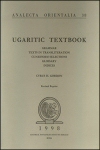
The Ugaritic Textbook is divided into 3 volumes. Volume 1 is a grammar. Volume 2 contains a great selection of texts in transliteration as well as a smaller selection of texts transcribed in the cuneiform script. The Logos Bible Software edition of these texts will be able to link and scroll with the Texts along with the Ugaritic Databank. Volume 3 is a glossary for looking up Ugaritic words, and contains a variety of indices to all three volumes.
This product will download as a single resource.

Ugaritic-Hebrew Philology is structured as addenda and corrigenda to Gordon’s Ugaritic Textbook. All three sections of Gordon’s work – grammar, texts, and glossary – are taken into consideration and commented upon in various details. The Logos Bible Software edition of these texts can be linked together, making it easy to find places where Dahood comments on Gordon’s text. The glossary section will function as a KeyLink destination for looking up Ugaritic Words, just like the glossary in Gordon’s Textbook.
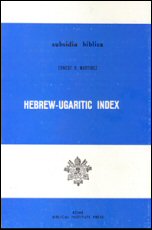
These two volumes provide an index to all the scripture references, words and grammatical functions discussed in the collected writings of Mitchell Dahood related to Ugaritic and the Hebrew Bible. In addition to indexing the writings of Rev. Dahood, pertinent reviews, related dissertations written by his students, and other relevant works are also indexed. Rev. Dahood was one of the most prolific writers on Ugaritic-Hebrew studies, and these volumes make it easier to locate what he had to say on many passages and words.

These outstanding volumes form a bridge between Ugaritic studies and Biblical studies. The Ras Shamra Parallels describe and index features in the Ugaritic tablets that shed some light on the Hebrew Bible. Features indexed include, poetic parallel pairs, professions, institutions, political and foreign affairs, literary genres, place names, words, phrases, flora, fauna, minerals, divine names and narrative structures.
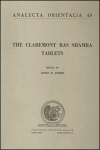
The Claremont Ras Shamra Tablets contains the editio princeps (the first scholarly publication) of six texts – two in Ugaritic and four texts from Ugarit that were written in Akkadian. These texts include photographs of manuscripts, transliteration, translations and commentary.
Reviews
5 ratings

James Brooks
8/24/2017
Meshaal
2/25/2017
Karl Lawrence Rupp
2/1/2017
Michael G Karnavas
7/20/2016
Christopher Allen Hutchens
9/29/2015
I am curious if these resources have a dictionary/lexicon/etc for a quick look up of words. Anyone know if they do?
Matthew Langlois
11/2/2013